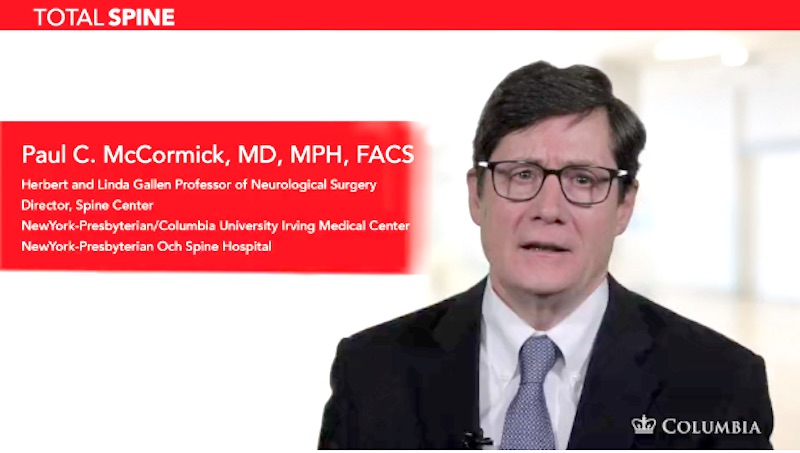| Header | Text |
| What is an Anterior Cervical Corpectomy? | Anterior = an anatomical term meaning “front”
Cervical = having to do with the part of the spine in the neck
Corpectomy = removal of damaged vertebrae and intervertebral disc (the “cushion” between the bones of the spine)
A corpectomy is a procedure that removes damaged vertebrae and intervertebral discs that are compressing the spinal cord and spinal nerves. An anterior surgical approach means “from the front of the body,” and the cervical spine is the spine in the neck. So an anterior cervical corpectomy is a procedure that removes damaged vertebrae and intervertebral discs from the spine in the neck, using a surgical approach through the front of the neck.
A corpectomy is similar to a related procedure called a discectomy, and the two surgeries may be used to treat similar conditions. The difference is that a corpectomy is a more extensive procedure, typically used when disease extends beyond the areas than can be dealt with through a discectomy alone. In a discectomy, only the damaged portion of a disc and bone spurs are removed, whereas in a corpectomy, the discs, bone spurs, and vertebrae are removed.
|
| When is this procedure performed? | An anterior cervical corpectomy is performed for patients who have experienced degenerative changes in the cervical spine that have resulted in the formation of bone spurs (bony projections) and/or herniated discs. These changes can take up space needed by the spinal cord and nerves within the spinal canal. In other words, these changes cause stenosis, or a narrowing of the spinal canal. As a result of stenosis, the spinal cord and nerves can be compressed (pinched) and even injured. Vertebrae that have been damaged by trauma, tumors, or deformity may also require a corpectomy.
Before surgery is considered, the doctor may recommend nonoperative measures such as pain medications and physical therapy. These measures are often effective, and they avoid the risks that attend any kind of surgery. However, surgery is typically the recommended treatment when the spinal cord is at risk of damage.
Surgery is typically considered if:
- a patient’s symptoms do not respond to nonoperative measures
- a patient’s pain is severe
- the spinal cord is compressed. With spinal cord compression, patients may experience:
- progressive neurologic deficit. These deficits usually cause numbness or weakness in the legs and arms.
- loss of bladder and/or bowel control
- difficulty walking
- impairment of coordinated movements of the hands, as in buttoning, tying and typing
|
| How is this procedure performed? | This procedure is performed under general anesthesia.
During the procedure, the surgeon will first make an incision on the front of the neck, moving aside muscle and other tissue to reveal the bones of the spinal column. The surgeon will then remove the damaged vertebra and the attached discs both above and below the damaged vertebra. This procedure, called decompression, relieves the pressure on the spinal cord and nerves.
Next, the surgeon will typically perform a spinal fusion to ensure the spinal column is stable. During a spinal fusion, the surgeon fills the space left by the discs and vertebra with an implant. An implant fills the available space, providing strength and stability to the spine.
A strut graft is one type of implant. This is a piece of bone 1-2 inches in length. It may be taken from the patient’s own body or from a bone bank. The strut graft is inserted into the available space in the spinal column and fixed in place with titanium screws and plates. Eventually, the graft bone fuses, or grows together with, bone native to the area. Good bony fusion is important for long-term spinal stability.
A cage is another type of implant. Cages are constructed entirely of a material like titanium, ceramic, or man-made bone. The cage is inserted into the space and fixed in place with screws and plates. Small bone grafts are used to help achieve fusion between the cage and the bone of the spinal column. The small pieces of bone used for grafting the cage are typically taken directly from the removed vertebra.
The incision is then closed with sutures and dressed with a small gauze bandage.
|
| How should I prepare for this procedure? | Make sure to tell your doctor about any medications that you’re taking, including over the counter medication and supplements, especially medications that can thin your blood such as aspirin. Your doctor may recommend you stop taking these medications before your procedure. To make it easier, write all of your medications down before the day of surgery.
Be sure to tell your doctor if you have an allergy to any medications, food or latex (some surgical gloves are made of latex).
On the day of surgery, remove any nail polish or acrylic nails, do not wear makeup and remove all jewelry.wigs/hairpiece. Also, you will need to remove contact lenses, eyeglasses, and dentures.
If staying overnight, bring items that may be needed, such as a toothbrush, toothpaste, and dentures.
|
| What should I expect after the procedure? | How long will I stay in the hospital?
Patients usually stay in the hospital overnight after the surgery and are discharged the next day.
What is the follow-up schedule?
At discharge, the incision is usually covered with a surgical dressing or steri strips. You will be instructed when to remove these, usually by postoperative day #7.
The surgeon will schedule a follow up visit, typically 4-6 weeks after surgery. X-rays will be done at that visit to monitor the healing and bony fusion.
The total recovery period ranges from 6 to 8 weeks.
Will I need to take any special medications?
After the general anesthesia of surgery wears off, some patients experience nausea that can be eased with medication.
The surgeon will typically prescribe oral pain medications and/or muscle relaxants to be taken at home. The medication is weaned off over the course of your recovery.
Will I need to wear a collar?
In most cases, the surgeon will recommend that the patient wear a cervical collar for several weeks until the bone graft has begun to heal. The collar supports the neck muscles during healing. The collar is not worn while eating, bathing or sleeping. Pediatric patients may wear a halo vest.
When can I resume exercise?
Patients are usually encouraged to increase their activities as they are able to tolerate, but should refrain from strenuous exercise until cleared by the surgeon. Walking is your best exercise during recovery. Avoid impact activity.
Will I need rehabilitation or physical therapy?
Physical therapy may be prescribed. In some cases, surgeons may wait an additional 4-6 weeks to allow more healing before starting neck exercises.
Will I have any long-term limitations due to this procedure?
There are no long-term limitations due to anterior cervical corpectomy.
|
| Preparing for your appointment | Drs. Paul C. McCormick, Michael G. Kaiser, Peter D. Angevine, Alfred T. Ogden, Christopher E. Mandigo, Patrick C. Reid and Richard C.E. Anderson (Pediatric) are experts in anterior cervical corpectomy.
|


